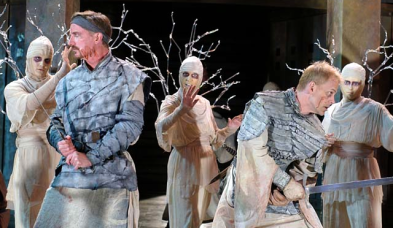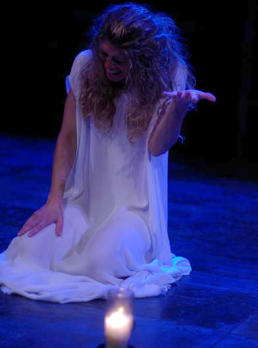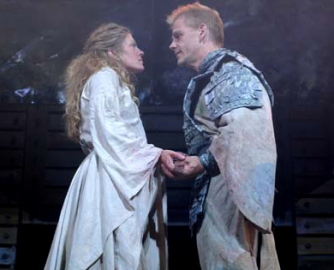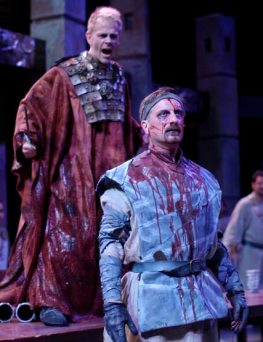Summary 
Stiffly staged battle sequences on a clumsy set, but a pair of strong lead performances - a shrewd and wily Lady along with a lusty medieval warrior Macbeth - elevate a traditionally set production. Memorably unique witches resemble fallen and mummified angels, haunting a hero tragically turned tyrant by degrees.
Design
Directed by Karen Kessler. Set by Ron Keller. Costumes by Kathryn Rohe. Lights by Julie Mack. Sound by Aaron Paolucci.
Cast
Philip Earl Johnson (Macbeth), Wendy Mortimer (Lady Macbeth), Eric Thibodeau (Duncan), Stephen Louis Grush (Malcolm), Ben Werling (Banquo), Jason Maddy (Macduff), Elizabeth Christine Tanner (Lady Macduff).
Analysis
Karen Kessler's traditional Macbeth at the Illinois Shakespeare Festival is significantly elevated by Philip Earl Johnson's title-role performance, which is at times stirring, frightening, poignant, and ultimately tragic. His multi-layered thane travels a tragic arc, from a fearless soldier, passionate husband and ambitious politician, who becomes conflicted and anguished with possibilities, then descends into helpless horror at his own bloody guilt as he continues to commit more and more heinous crimes. At the beginning of the production, Johnson's physical Macbeth, lithe and muscular with sandy brown hair and impish good looks, embodies the archetypal medieval warrior, wielding a broadsword and dressed in rag-like woolen layers.

Kessler stages the opening rebellion with rather slow-moving combat sequences that lumber rather than sprawl across the outdoor set. More than a dozen soldiers battle in worn leather boots, rag-like cloth, and studded vests of light leather and fur. They wield long swords and wear pointy helmets, grunting and shouting on parquet-style floor panels in front of horizontal wood-slatted walls. Columns of rectangular stone support the balcony, and above stand odd stacked squares with what may be intended as stone but instead appear like crumpled aluminum, giving a standard medieval staging something of a disconcertingly post-modern Stonehenge feel.

Kessler's conception for the witches that haunt and taunt Macbeth more than makes up for the lackluster staging. The three witches appear in eerie yellow backlight, emerging from under the balcony, a creepy cross between ghoulish zombies in dark makeup, with purple circles around their eyes, and badly fallen angels with translucent horns on their back that glow with light like grotesque wings. Wrapped in three layers of white gauze garments and white headdresses like the bandages of mummies, the witches at some times resemble the battlefield dead, at others mutated animal-angels. The first witch appears behind a door upstage, a surreal yellow glow behind her. She is joined by the other witches and slowly approaches the battlefield, moving downstage unnoticed until just Banquo and Johnson's Macbeth remain. Their amplified prophesies strike a chord within Johnson's battle-weary Macbeth, who seems startled by the delicious-sounding possibilities.

Johnson's Macbeth continues across his impressive arc, revealing himself as at least secretly ambitious, and proving himself among Duncan's thanes as a respected presence and something of a politician, carefully choosing his words and measuring his reactions, even the pang of disappointment at being passed over for Malcolm. His Lady, played with a complex blend of rural Scottish toughness and refined beauty by Wendy Mortimer, is an equal partner with her husband, fiery and lusty and shrewd. Mortimer's Lady, with long wavy light-brown hair in flowing braids, kneels in white robes for her impassioned soliloquy, and when Johnson's Macbeth approaches her from behind with a lusty embrace, their onstage sexuality simmers. Now a smoldering young lover confiding his desires, Johnson's Macbeth approaches the point of no return, and his expressions become more stiff and reflective as he frowns and frets during the celebration with Duncan. The guests at Dunsinane, all attired in silverish tunics - the men wearing rough brown belts and carrying tankards of wine - are greeted by the firmly-resolved Lady Macbeth in her cream-and-white layered gown. Mortimer's Lady steels her husband nerves, then after the murder finds him horrified with himself, anguished and on the verge of hysteria. Johnson's Macbeth stares at his hands in the shadows beneath the balcony, then reaches up for her - leaning down to him from the balcony - but quite poetically finds that his Lady is now beyond his reach.

After Banquo - in the production's strongest supporting performance, from a stately Ben Werling - is surprised by Macbeth's three murderers, Johnson's Macbeth hosts a banquet, his resolve stiffening ("not just thus, but safely thus") as he seems to hope there is no degree to damnation. The Last Supper-like banquet, with Macbeth and the Lady at the center, four guests on either side of them, is lit in purple as if an open-air feast, and Johnson's Macbeth moves far downstage in his rusty cranberry-red robe with metallic collar, a chain medallion halfway down his chest, to make a toast. Werling's goateed Banquo, bloody-faced and glaring, purple circles around his eyes much like the witches', emerges from beneath the balcony to take his seat at the table. When Banquo, his head wrapped in a bluish-green bandana like a bandage, appears a second and third time, Johnson's Macbeth panics, making an athletic leap atop the banquet table in a frightened rage to confront the surreal image of the ghost. But degrees of horror prove real, and the second appearance of the prophesying witches is more frightening, and they emerge insect-like from an upstage trap that billows smoke in front of a glaring white light. The dark shapes emerge, each limb pronounced in the backlit fog, their faces concealed with gauze masks. They taunt Johnson's Macbeth with orbs, show him a crowned head and - quite oddly - a transparent see-through doll of a baby. Werling's Banquo then appears to offer an orb to Macbeth, but he directs a procession of kings in glowing crowns that appear in the balcony and march silently to descend to the stage and disappear in the darkness upstage.
The assault on the Macduff family marks Macbeth's nadir in his slide into depravity. Kessler stages the scene before a series of sheets hanging like drying linen from a line upstage. A little boy scurries, a wicker bassinet off to one side, watched by a little girl. The murderers chase the children and drag the entire family behind the billowing sheets, executing them in a vividly realistic orange-lit shadow play. And Mortimer's once-radiant Lady Macbeth, now a shell of herself much like Johnson's seething Macbeth was once a proud and respected warrior, emerges hysterical in a long white nightgown, candles on the stage around her as she tries to cleanse ("out damn'd spot!") the murderous sins from herself. Kessler's stage is a murky blue glow, and Mortimer gestures with frantic fury as if possessed with demons.
Johnson - whose Illinois Shakespeare Festival starring roles include both Berowne and Coriolanus in 2001, a fabulous Petruchio in 2000, and Angelo and Benedick in 1998 - deftly blends depraved defiance with disgusted self-loathing during the final conflict. Once faced with Macduff and without his "charmed life," Johnson's Macbeth comes full circle, again eager to fight, but suddenly only for the honor of never saying surrender. After a strange Birnam Wood sequence, in which stern-visaged soldiers struggle with unwieldy, ten-foot tall shields that are lit on the purple stage with green to unconvincingly simulate towering trees, Kessler moves the action through slow combat sequences to the Macbeth-versus-Macduff finale. Johnson's Macbeth gains the upper hand and stands behind a kneeling Macduff, a knife at his throat, but in a pang of conscience hesitates and is then killed - or, rather, put out of his misery - by Macduff. Kessler's serviceably traditional production comes to its satisfying conclusion, elevated by Mortimer's fiery Lady and especially by the wide-ranging emotions of Johnson's tragic anti-hero.